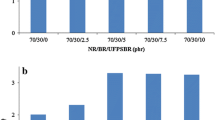Abstract
Neoprene rubber (CR) plasticized with low viscosity benzoxazine prepolymers (CRDBz and CRTBz) are fabricated by a novel process using co-curing mechanism. In this study, the influence of these prepolymers on the mechanical properties and processing behavior of CR has been investigated. It was found that the oscillating torques of DBz, TBz and DOP are 1.27 μN·m, 0.99μN·m and 0.50μN·m at 60 ℃, respectively. Tg decreased with increased DBz and TBz loadings of 5, 10, 15 phr, when the addition amount of DBz and TBz is 10 phr, the glass transition temperature (Tg) of CRDBZ10 and CRTBz10 is -41.70 ℃ and -40.44 ℃, respectively, lower than that of CR, -31.68 ℃. Compared with CR vulcanized rubber, the tensile strength of CRDBz10 and CRTBz10 was increased by 46.2% and 85.7%, respectively, and the elongation at break was increased by about 65.8%% for CRDBz10 and by about 44.4% for CRTBz10. Scanning electron microscope analysis (SEM) provides evidence that adding benzoxazine prepolymer has obvious plasticizing effect. The results of the ageing in ASTM-3 oil (100 ℃ × 72 h) indicated that prepolymers of DBz and TBz had both plasticizing and enhancing effects in CR materials.










Similar content being viewed by others
Data availability
Data not available due to commercial restrictions.
References
Plazek DJ, Plazek CT (2021) A history of Andrade creep and the investigation of the dielectric dipolar Andrade creep. J Non-cryst Solids 5001:120625
Ngai KL, Plazek DJ (2005) The viscoelastic behavior of rubber. Sci Technol Rubber 183–236
Karadeniz K (2012) Investigation of plasticizer effect of Hazelnut Oil and its epoxidized derivative on chloroprene and nitrile rubbers. Kautsch Gummi Kunstst 65:49–54
Varghese LA, Thachil ET (2004) Studies on the adhesive properties of neoprene–phenolic blends. JAST 1:181–193
Schaffert A, Arnold J, Karkossa I et al (2021) The emerging plasticizer alternative DINCH and its metabolite minch induce oxidative stress and enhance inflammatory responses in human THP-1 macrophages. Cells 10:2367
Suyatma NE, Tighzert L, Copinet A et al (2005) Effects of hydrophilic plasticizers on mechanical, thermal, and surface properties of chitosan films. J Agric Food Chem 53:3950–3957
Zhao S, Shao XM, Liu XL et al (2018) Lubrication and plasticization behavior of large-size micro-spherical structured SiO2 for natural rubber. RSC Adv 8:31783
Olsson E, Larsson PL et al (2014) On the tangential contact behavior at elastic-plastic spherical contact problems. WM 319:110–117
Thien DT, Khoi NV, Khang DQ et al (1996) Modification of rubber by cardanol-formaldehyde resins and epoxidized cardanol. J Macromol Sci A 33:1963–1972
Liang GG, Cook WD, Sautereau HJ et al (2009) Diallyl orthophthalate as a reactive plasticizer for improving PVC processability, Part III: Curing, properties, and phase separation. Polymer 50:2655
Liang GG, Cook WD, Sautereau HJ et al (2009) Diallyl orthophthalate as a reactive plasticizer for improving PVC processibility, Part II: Rheology during cure. Polymer 50:2635–2642
Zhang W, Jiang N, Zhang T (2021) Synthesis and properties of corresponding polymers of urushiol-based benzoxazine monomers modified by silane. Int J Polym Anal Charact 26:1–11
Zhang W, Jiang N, Zhang T et al (2021) Preparation and properties of silane-modified cardanol–benzoxazine for hydrophobic coating. J Elastom Plast 53:296–310
Zhang W, Jiang N, Zhang T et al (2020) Thermal stability and thermal degradation study of phenolic resin modified by cardanol. Emerg Mater Res 9:1–6
Lochab B, Shukla S, Varma IK (2014) Naturally occurring phenolic sources: monomers and polymers. RSC Adv 42:21712–21752
Sun J, Wei W, Xu Y, Qu J, Liu X, Endo T (2015) A curing system of benzoxazine with amine: reactivity, reaction mechanism and material properties. RSC Adv 5:19048–19057
Manalo AC, Wania E, Zukarnaina NA, Karunasenaa W, Lau K (2015) Effects of alkali treatment and elevated temperature on the mechanical properties of bamboo fibre–polyester composites. Compos B 80:73–83
Rajesh Kumar S, Asseref PM, Dhanasekaran J et al (2014) A new approach with prepregs for reinforcing nitrile rubber with phenolic and benzoxazine resins. RSC Adv 4:12526
Forrest MJ (2001) Rubber analysis-polymers, compounds and products. Rapra Rev Rep 12:1–148
Funding
Wenzheng Zhang appreciates the financial support from Foundation of Liaoning Province Education Administration (Grant No. LJ2020007) and Shenyang Science and Technology Bureau, LiaoNing Province (Grant No.22–101-0–26 and Grant No.22–316-1–03). Zan Wang is grateful to the Science and Technology Funds from Foundation of Liaoning Province Education Administration (Grant No.LJ2019012).
Author information
Authors and Affiliations
Contributions
Conceptualization, Wenzheng Zhang; methodology, Wenzheng Zhang and Zan Wang; validation, Tingting Zhang and Li Huang; formal analysis, Wenzheng Zhang and Jiangnan Mou; investigation, Wenzheng Zhang and Zan Wang; data curation, Li Huang and Zan Wang; writing—original draft preparation, Tingting Zhang; writing—review and editing, Wenzheng Zhang; project administration, Wenzheng Zhang. All authors have read and agreed to the published version of the manuscript.
Corresponding authors
Ethics declarations
Competing interests
The authors have no relevant financial or non-financial interests to disclose.
Additional information
Publisher's Note
Springer Nature remains neutral with regard to jurisdictional claims in published maps and institutional affiliations.
Rights and permissions
Springer Nature or its licensor (e.g. a society or other partner) holds exclusive rights to this article under a publishing agreement with the author(s) or other rightsholder(s); author self-archiving of the accepted manuscript version of this article is solely governed by the terms of such publishing agreement and applicable law.
About this article
Cite this article
Zhang, W., Zhang, T., Huang, L. et al. Plasticization and reinforcement behavior of low viscosity benzoxazine prepolymers for neoprene rubber. J Polym Res 30, 107 (2023). https://doi.org/10.1007/s10965-022-03425-4
Received:
Accepted:
Published:
DOI: https://doi.org/10.1007/s10965-022-03425-4




